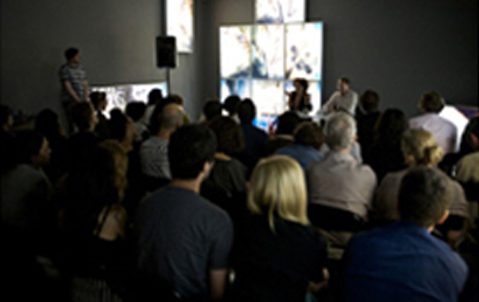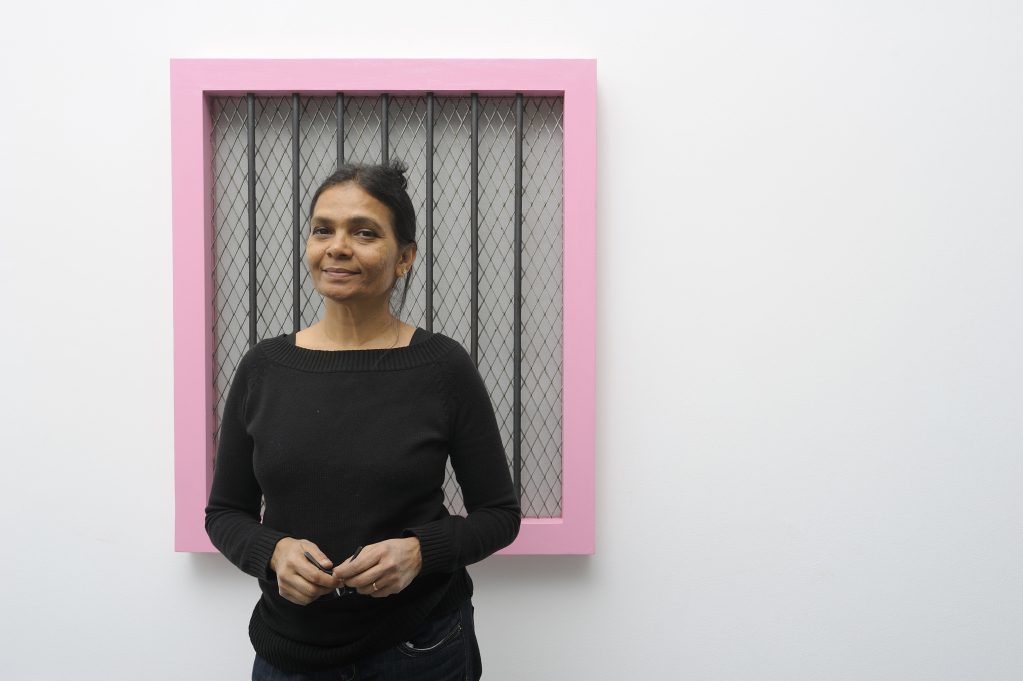- Venue
Rivington Place
-
Time
6:30pm
-
Admission
Free
- Artists
Concrete Colour
Film program responding to Sheela Gowda’s ‘Therein & Besides’
– with introduction and post screening discussion.
This selection of short films moves from abstraction to the concretely political. This stems from an attempt to meet Sheela Gowda’s work and interrogate layers of violence present in the context of a material to its habitat. Those relations are explored cinematically, as uneasy, steady and committed, from the perspective of the filmmaker / artists as well as the subjects they attend to. As is the case with the documentary mode each short film embodies a processual relation to its own truth while being dedicated to the political.
Each filmmaker is a proponent of a particular aspect of experimental and documentary filmmaking within the Indian context, although they have not been chosen to represent a particular point of view.
Films
Rahi Zindagi Tu Phir Milenge – This Extra Green
D: Wasim Mushtaq Wani, Kashmir, 2007, Mini DV, 5 min
Rahi Zindagi Tu Phir Milenge – Hope to see you again if I stay alive. This extra green recalls the intimidating presence of the Indian Army in the Kashmir Valley. “We rarely see a so-called terrorist as a visible moving image in our inconspicuous day to day experience. They are hiding and I don’t think most of my friends would disagree with me if I say that their absence – their being outside the frame is as insidious an absence as it is being sold outside the state.” Wasim M. Wani
Et cetera – A Tetralogy. Part I: Renunciation
D: Ashish Avikunthak, India, 1997, 16mm, 5.30 min.
Et cetera comprises four separate films made between 1995-1997. Each part seeks to examine the various levels at which the reality of human existence functions. Specific ritual exercitations have been focused on and their movements, contemplated upon, by studying the dynamics of their etymologies.
Vakratunda Swaha
D: Ashish Avikunthak, India, 2010, 35mm, 21 min.
In 1997, I filmed a sequence – a friend immersing an idol of Ganesha at Chowpati beach, Bombay on the last day of the Ganapati festival. A year later, he committed suicide. After twelve years, I completed the film. Using his footage as the leitmotif, this film is a requiem to a dead friend.
One Way
D: Ayisha Abraham, India, 2007, Mini DV, 15 min
One Way is set in the underground parking lot of an apartment building in Bangalore, in South India. The film follows the livelihood of a security guard named Shyam Bahadur, who lives with the rest of his family in the electric switching room of an apartment block, to whom he provides service for the sake of survival. The narrative of the journey he made 35 years ago, from the mountains of Nepal to the southern plateau of Bangalore, punctuates his day-to-day life in and out of the basement. As his personal story unfolds, the hills of Nepal are being rocked by “the people’s war,” yet another historical disturbance that has forced Nepalis to emigrate for work.
Vertical City
D: Avijit Mukul Kishore, India, 2010, HD, 34 min.
A visual essay on the architecture of a dystopia. In a far suburb of Bombay, residents from slums are moved into high-rise apartment complexes with the promise of a better life. While these complexes are built allegedly to house the poor, they have been seen as moves to free prime slum land for commercial development. The complexes soon degenerate into places worse than slums. The film lets the viewer experience the living conditions of places hidden away in a 21st century metropolis.
Under the table
D: Wasim Mushtaq Wani, Kashmir, 2010, Mini DV, 4.20 min.
Those Kashmiris, who live a relatively comfortable and peaceful life outside Kashmir, respond to the stories of human loss, torture and pain as they receive them in the form of news or directly through a personal mobile. The table, especially when somebody is sitting on a chair and using it for a certain defined purpose, dissects that given space into two major parts. One is the hidden part beneath the torso and the other is the obvious half, which addresses the open/public identity of the sitter. Under the table might be a questioning of ones moral and intellectual responsibility on the one hand and some kind of fixity with complacency.
Snow – Hum Kiya Chahte
D: Wasim Mushtaq Wani, Kashmir, 2009, Mini DV, 3 min.
There is a certain inner compulsion that often drives me to wonder about the circularity of events where we humans perform the stereotyped reproducing machine. This eternal recurrence; this incorrigible temptation for power and iconization consequentially graduates into a flat two-dimensional state of taken-for-granted-ness. It is like making a full circle in the constellation of circles where each circle parodies the same old story beginning with the charm of spring, passion of summer, the bliss of autumn and then, as most of the great stories tend to be tragic in the end, everything buries under the white cloth ready for resurrection – the promise never realized. Snow is a metaphor for sweeping away every visible evidence of familiar reality in order to refresh the appetite to feel the newness in the old. It links to a re-thinking of the form and nature of slogans, used or abused for the sake of a cause.
Book online here or alternatively you can contact: bookings@rivingtonplace.org or call 020 7749 1240
Bangalore based artist Sheela Gowda presents her first solo exhibition in the UK at Rivington Place, including a new commission. Gowda is known for creating large-scale sculptural installations which take everyday materials as the starting point and for works that combine abstract forms with references to society.

